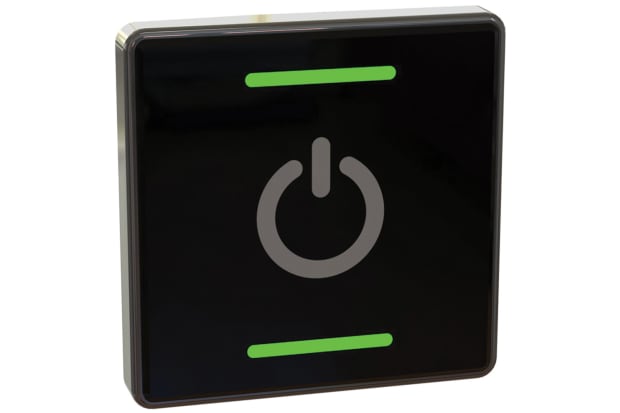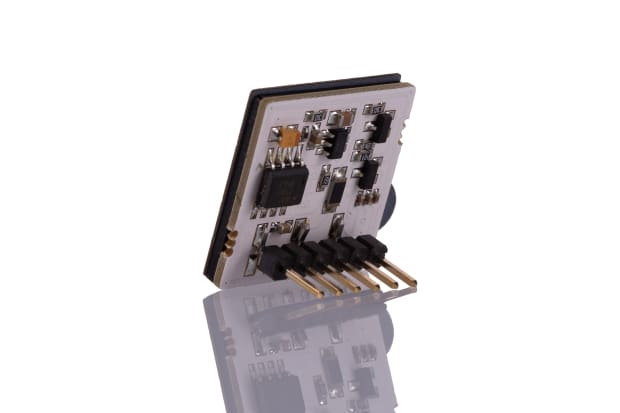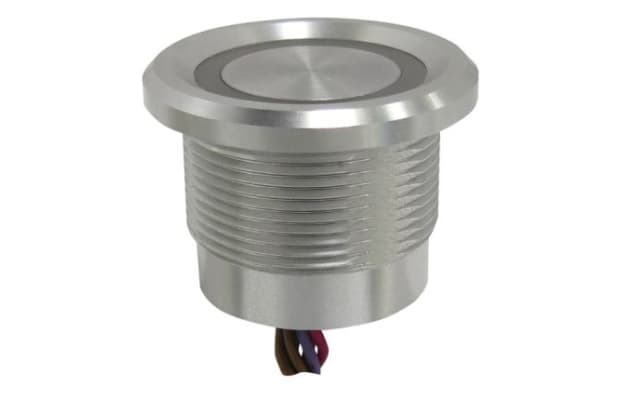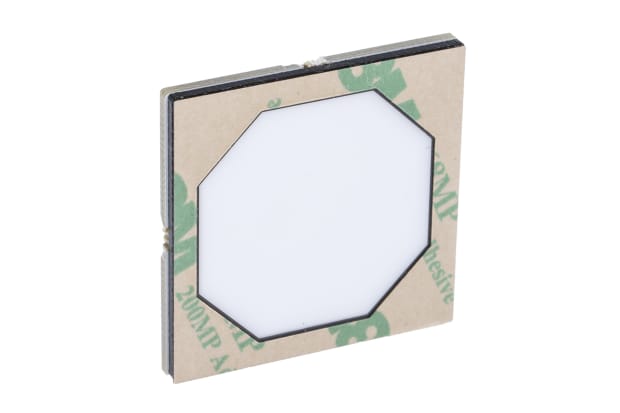- Published 5 Jan 2023
- Last Modified 29 Aug 2023
- 10 min
Touch Switches: A Complete Guide

This guide is part of our Industrial Automation hub where you can discover more about AI, automation and control.
In this guide, we’ll look more closely at the various types of touch switches available, as well as giving a brief overview of how different touch switches work.
What are touch switches?

A touch switch, as the name suggests, is one of various types of activation switches that need only be subjected to some degree of physical contact/pressure from an operator or object in order to actuate.
Touch switches are, in many ways, the simplest kind of tactile sensor; they are most often a type of binary on/off electronic switch that will only be actuated when there is direct physical contact or some degree of pressure being applied to it.
Thanks to their ability to work when mounted on or behind the surface of numerous panel types and displays (including glass, acrylic and plastic), touch switches are very widely used in a huge variety of different applications, both household and workplace. Multiple touch switches are often arranged in sequence on a single panel or display - for example in a multi-function keypad - allowing for more diverse control inputs to manage various types of applications and tasks.
Common industrial and domestic uses for touch switches might include, for example:
- Lighting circuits and lamp housings
- Laptop and smartphone touchscreens
- Industrial automation equipment
- Medical devices and controls
- Defence, safety and alarm systems
- Audio and broadcast hardware
The looks, features and performance of different sorts of touch switch can be tweaked by manufacturers - and often end users - to alter everything from the colours and brightness of their LED components, to the responsiveness of a given switch under differing amounts of pressure (high, medium and low sensitivity switches can all be programmed, depending on the application they’re intended for use in).
How touch switches work

Although a very wide range of different sorts of touch switches and sensors exists, they all have some basic fundamentals in common.
All kinds of tactile sensors are responsive to some external direct stimulus - be it touch, force or pressure - and their connections are generally made or broken on the basis of responsiveness to light (optical), electricity, magnetism, or some other chemical or mechanical trigger. In other words, they all use a sort of on/off stimulus-to-response pathway.
In some cases, this will be an incredibly simple sequence of inputs and outputs - for example, the individual keys on a computer keyboard are examples of very basic touch switches, which respond to direct physical pressure in order to tell the computer which key is being pressed at which time.
More complex versions of touch switches are found on, say, smartphone screens - often incorporating other features such as capacitive sensing and haptic feedback - but, regardless of the type of sensing/delivery system being deployed, all work along the same basic principles as one another once the actuation has taken place.

As we’ve already noted, touch switches are nigh-on ubiquitous features today, appearing on countless types of different high-end modern devices - but, perhaps surprisingly, they’re actually not that new a technology. While touch switch formats have advanced significantly, and been greatly refined with successive leaps in design and manufacturing methods, the basics of using the human body as a conductor - which it’s very well equipped for - have been understood and exploited for years.
Temperature, resistance and capacitance are all types of touch switch mechanisms that work consistently well when operated by a person, or a suitable switch manipulation object. The way in which a particular touch switch works is entirely dependent on the type of touch switch technology in question, and so in the following section we’ll explore some of the more common kinds of touch switches sold on the market.
Types of Touch Switches
As we’ve already outlined, there are numerous types of touch switches available to buy for all manner of different projects and functions. These are often quite broadly defined under the umbrella term ‘touch switches’ to refer to any switch that doesn’t require a significant amount of physical pressure to actuate.
Although technically speaking, it should only really denote capacitive or resistive switches, we’ll also include the very common subtype of push-button switches in this round-up, as they’re among the most widely available products in the direct contact switch segment of the market.

Push Button Switches
Push button switches - also known as ‘momentary’ or ‘contact’ switches - are among the simplest and most widely available kinds of touch switch sold today (although, as noted above, they’re arguably not true ‘touch switches’ at all).
A push button switch is non-latching, meaning it only affects the circuit it’s connected to for as long as it’s being physically actuated (pushed down); as soon as the pressure on the switch is removed, it returns to its default position. This is usually achieved via a basic automatic mechanism such as a spring, and the initial circuit condition will be restored once the spring is released.
The two types of push button switches most commonly sold by suppliers are ‘push to make’ and ‘push to break’ versions. As you’d assume, one breaks the circuit when under a force load (i.e. pushing the button effectively turns the circuit ‘off’), while the reverse is true of a push-to-make connection. Push button touch switches can commonly be designed to offer both functions, depending on how they’re wired up to the circuit.

Capacitive Switch
Capacitive switch technology is one of the two main types that most people would strictly define as a true touch switch. Rather than requiring any sort of actual physical pressure to actuate, capacitive switches function by measuring a small electrical charge that gets transferred from your body to the switch itself. This happens more or less the instant you make a clean contact with it.
What’s actually going on is that the small electrical charge coming from the object or person triggering the switch causes a change in capacitance, effectively disturbing the existing electrical charge contained within the minute wiring of the switch itself. The switch can ascertain from this change in electricity flow precisely when, where and how it was pressed, and thus trigger the corresponding function(s) it’s been wired to perform.
Capacitance touch switch circuits work with human skin precisely because it’s electrically conductive (after all, our bodies are mostly made up of water) - and that’s also why they work with pretty much anything else that holds a small amount of electrical charge. For this reason, you’ll often find you can operate a capacitive touch switch with any number of random objects held in the hand, rather than with your hand itself.
A bar of soap or a chunk of freshly cut potato, for instance, will operate a standard touch lamp perfectly well - whereas you’ll get nowhere trying to turn it on and off with a piece of stone, dry wood or fabric. If the object in question happens to be an effective enough insulator, it will block the flow of electricity between you and the switch and no actuation will occur. For this reason, objects intended explicitly for the manipulation of touch switches (a stylus, for example) must be specifically designed to be capacitive too.
Capacitive touch switch kits can be used in a very broad array of applications and environments, including everything from smartphones and industrial controls to vending machines and common household appliances. They’re frequently found incorporating a wide range of other features, such as LED backlighting and IP ratings, making them among the most widely used touch switch types in harsh environment settings.
The lack of mechanical (i.e. moving) parts in a true capacitive touch switch means they’re generally seen as particularly robust, durable and reliable options, suitable for a range of industrial and outdoor applications in all manner of different panel and screen types.

Piezo Touch Switch
A piezo switch derives its name from the piezoelectric effect, which occurs when a degree of mechanical stress - i.e. a bending force, in simple terms - is applied to certain solid materials. These materials include some types of crystals, certain ceramics, and various sorts of biological matter (bone, DNA, numerous proteins).
The piezoelectric effect causes an electrical charge to build up in these materials when a mechanical stress force is applied, and in the right materials it can be witnessed even when the stresses occur at very low levels.
Piezo switch circuits contain an inner layer - often ceramic - which depresses very slightly when light pressure is applied to the outer layer of the switch casing (typically metal). This causes the disc-shaped inner layer to bend fractionally out of shape, a little like the skin of a drum when hit, and this distortion in turn creates a single brief pulse of electrical voltage. In most cases, this will trigger an integrated semiconductor device that registers the switch circuit as active for the duration of the press.
Because the microscopic bending on the inner disc layer constitutes the only moving part within a piezo touch switch, they’re typically able to offer excellent durability and resilience in frequent use. Piezo switches designed for extremely heavy workloads will often be reinforced with a more robust metal outer casing, and may require more force to actuate than the average model in this category.
They’re also easy to seal against moisture or dirt ingress, making them well-suited to harsher environments such as outdoor applications. Again, while often considered within the wider context of true touch switches, piezo circuits do require some actuation force (even if extremely low) in order to register a ‘press’, and so might properly be considered in a comparable but somewhat distinct category of touch switch to capacitive and resistive varieties.
Resistive touch switch
Resistive touch switches, like capacitive touch switches, also operate by registering changes in electrical current. However, comparatively speaking, resistive touch switches are much more simple in design and construction than the relatively complex capacitive varieties. Resistive switches rely on lowering the resistance - in short, bridging the electrical ‘gap’ - between two conductive metal plates that are laid out with a small but electrically important space in between.
When your finger alights on a resistive touch switch, it makes contact with both plates at the same time, whereupon the water and salts in human skin help to conduct the flow of electricity across this gap, effectively completing the circuit, This actuates the switch, triggering whatever function is has been wired to perform when the contacts are closed.
The simplicity of this design brings with it some obvious benefits - not least that they’re a far more economical choice for the majority of suitable applications, as well as being a fairly robust, consistent and long-lasting option in most scenarios. However, they’re somewhat limited in the range of functions they can perform, due to their extremely binary sensitivities: as a pure on/off touch switch, they don’t support multi-touch operation, for example, making them unsuitable for high-end smartphones and similar devices.
Product spotlights
Shop our best selling touch switches:
Related links
- APEM Capacitive Switch Momentary Green NPN IP69K
- Network Switches - A Complete Guide
- Vacuum & Pressure Switches - A Complete Guide
- A Complete Guide to Toggle Switches
- RS PRO Capacitive Switch Latching NO Green, IP68 Brass
- RS PRO Capacitive Switch Latching NO Green IP68 Brass
- RS PRO Capacitive Switch Latching NO Blue IP68 Brass
- A Complete Guide to Reed Switches


